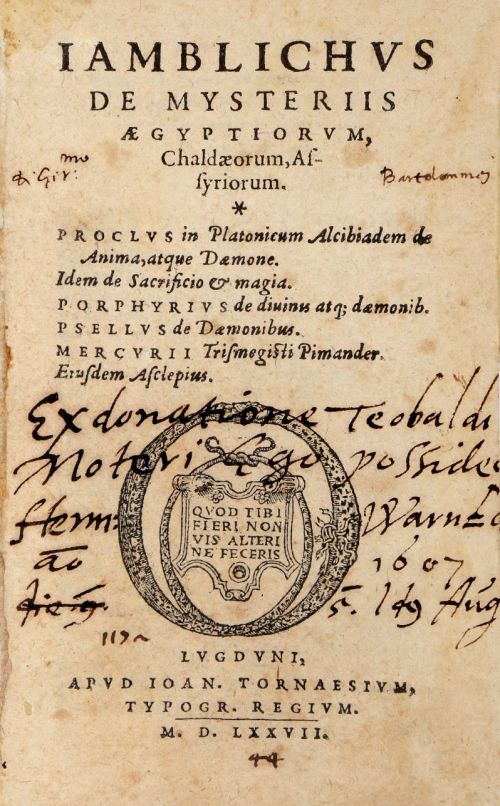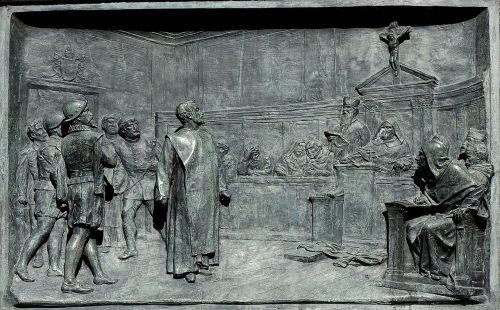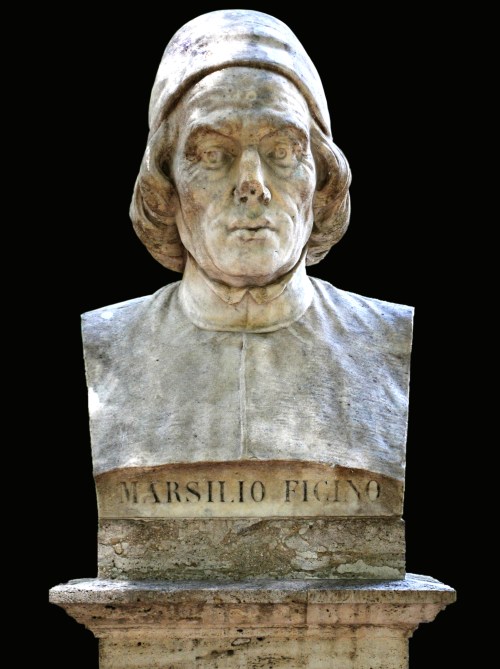“Giordano Bruno’s cosmological vision presented a world without ends, whose circumference, as Nicholas of Cusa had already argued, was nowhere to be found, and whose center was everywhere, at whatever point the observer chose to contemplate the universe in its infinity and substantial unity.
The panpsychism of Bruno had a Neoplatonic foundation: there was but a single divine breath, one principle of motion pervading the whole of the infinite universe, determining it in its infinite variety of forms.
The master idea of an infinite number of worlds was compounded with the notion that every earthly object can also serve as the Platonic shade of other ideal aspects of the universe. Thus every object exists not only in itself, but as a possible sign, deferral, image, emblem, hieroglyph of something else.
This worked also by contrast: an image can lead us back to the unity of the infinite even through its opposite. As Bruno wrote in his Eroici furori, “To contemplate divine things we need to open our eyes by using figures, similitudes, or any of the other images that the Peripatetics knew under the name of phantasms” (Dialoghi italiani, Florence: Sansei, 1958: 1158).
Where they did not emerge directly from his own inflamed imagination, Bruno chose images found in the Hermetic repertoire. These served as storehouses of revelations because of a naturally symbolic relationship that held between them and reality.
Their function was no longer, as in previous arts of memory, that of merely helping to order information for ease of recall, or this was, at least, by now a minor aspect: their function was rather that of helping to understand. Bruno’s images permitted the mind to discover the essence of things and their relations to each other.
The power of revelation stored inside these images was founded on their origin in far-off Egypt. Our distant progenitors worshipped cats and crocodiles because “a simple divinity found in all things, a fecund nature, a mother watching over the universe, expressed in many different ways and forms, shines through different subjects and takes different names” (Lo spaccio della bestia trionfante, Dialoghi italiani, 780-2).
But these images possess more than the simple capacity to reawaken our dormant imagination: they possess an authentic power to effect magical operations on their own, and functioned, in other words, in exactly the same way as the talismans of Ficino.
It is possible, of course, to take many of Bruno’s magical claims in a metaphorical sense, as if he was merely describing, according to the sensibility of his age, intellectual operations. It is also possible to infer that these images had the power to pull Bruno, after prolonged concentration, into a state of mystic ecstasy (cf. Yates 1964: 296).
Still, it is difficult to ignore the fact that some of Bruno’s strongest claims about the theurgic potential of seals appeared in a text that bore the significant title of De Magia:
“nor even are all writings of the same utility as these characters which, by their very configuration, seem to indicated things themselves. For example, there are signs that are mutually inclined to one another, that regard each other and embrace one another; these constrain us to love.
Then there are the opposite signs, signs which repel each other so violently that we are induced to hatred and to separation, becoming so hardened, incomplete, and broken as to produce in us ruin. There are knots which bind, and there are separated characters which release. [ . . . ]
These signs do not have a fixed and determined form. Anyone who, obeying his own furor, or the dictates of his soul, naturally creates his own images, be these of things desired or things to hold in contempt, cannot help but represent these images to himself and to his spirit as if the imagined things were really present.
Thus he experiences his own images with a power that he would not feel were he to represent these things to himself in the form of words, either in elegant oration, or in writing.
Such were the well-defined letters of the ancient Egyptians, which they called hieroglyphs or sacred characters. [ . . . ] by which they were able to enter into colloquies with the gods and to accomplish remarkable feats with them. [ . . . ]
And so, just as, where there lacks a common tongue, men of one race are unable to have colloquies with those of another, but must resort instead to gestures, so relations of any sort between ourselves and certain powers would be impossible were we to lack the medium of definite signs, seals, figures, characters, gestures, and other ceremonies.”
(Opera latine conscripta, Naples-Florence, 1879-1891, vol. III: 39-45).
Concerning the specific iconological material that Bruno employs, we find figures deriving directly from the Hermetic tradition, such as the Thirty-six Decans of the Zodiac, others drawn from mythology, necromantic diagrams that recall Agrippa or John Dee, Lullian suggestions, animals, plants and allegorical figures deriving from the repertoire of emblems and devices.
This is a repertoire with an extraordinary importance in the history of iconology, where the ways in which a certain seal, for example, refers back to a specific idea are largely governed by rhetorical criteria: phonetic similarities (a horse, equus, can correspond to an honest, aequus, man); the concrete for the abstract (a Roman soldier for Rome); antecedent for the consequent; accident for subject (or vice versa); and so on.
Sometimes the analogy is based upon the similarity of the initial syllable (asinus for asyllum); and certainly Bruno did not know that this procedure, as we shall see in chapter 7, was followed by the Egyptians themselves when using their hieroglyphs.
At other times the relations might be based on kabbalistic techniques such as anagrams or paronomasias (like palatio standing for Latio: cf. Vasoli 1958: 285-6).”
Umberto Eco, The Search for the Perfect Language, translated by James Fentress, Blackwell. Oxford, 1995, pp. 132-5.




